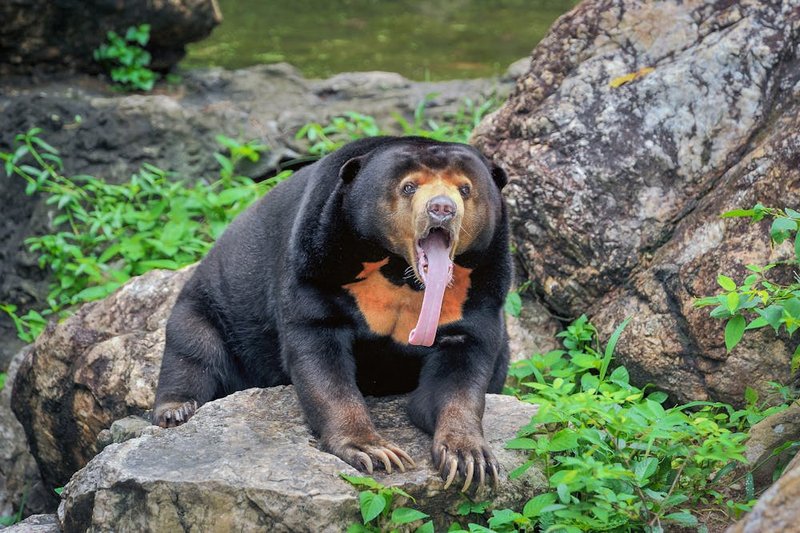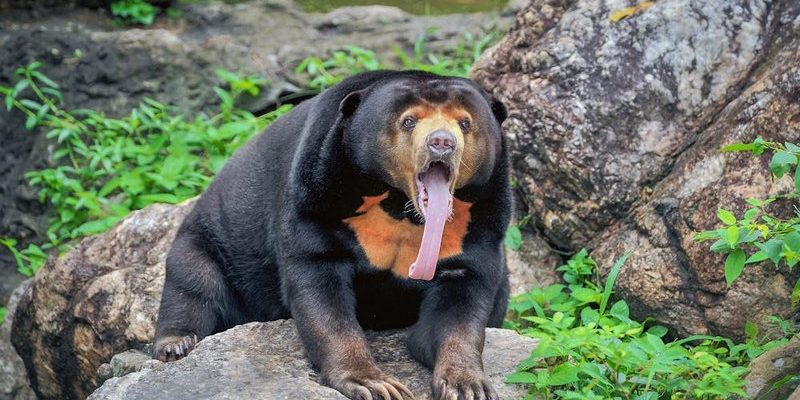
So, grab a cup of coffee and let’s dive into some of these common misunderstandings. Think of this as a friendly chat to clear the air about sun bears. You might be surprised at what you learn. From their diet to their habits, we’ll take a closer look at the truths and myths that surround these incredible animals.
Myth 1: Sun Bears Are Just Tiny Versions of Other Bears
One of the most persistent myths about sun bears is that they’re merely smaller versions of other bear species. While it’s true that they are the smallest bear, measuring only about 4.5 feet in length and weighing between 60 to 150 pounds, they are much more than just “mini bears.”
Sun bears have distinct features that set them apart. For instance, their fur is short and sleek, which helps them stay cool in their tropical habitats of Southeast Asia. They also have a unique yellow or white crescent shape on their chest that varies from one bear to another, making each sun bear a bit of a natural work of art. Plus, they have strong, curved claws that are perfect for climbing trees, which is an essential skill for finding food and escaping predators.
In essence, labeling sun bears as just “tiny bears” overlooks their unique adaptations and behaviors, like their knack for climbing to find tasty fruits and honey.
Myth 2: Sun Bears Only Eat Honey
Another common misconception is that sun bears are exclusively honey aficionados. While they indeed have a sweet tooth and are known for their ability to extract honey from the toughest beehives, their diet is actually much more diverse.
Sun bears are omnivorous, which means they enjoy a variety of foods. Their snack menu includes fruits, insects, small mammals, and even roots. Imagine a bear rummaging through the forest for juicy fruits or digging into the ground for tasty insects. These little bears are incredibly resourceful, using their impressive sense of smell to locate food sources.
So, while honey may be a highlight of their diet, sun bears are far from being one-dimensional eaters. They adapt their feeding habits based on what’s available in their environment, making them quite flexible and smart.
Myth 3: Sun Bears Are Aggressive
You might think that a bear, no matter the size, is always aggressive. However, that’s not entirely true for sun bears. While they do have a reputation for being more defensive than some other bear species, it’s important to understand the context.
Sun bears are typically shy and reclusive animals. They prefer to avoid confrontation whenever possible. When they feel threatened, they might display aggression, which is a natural instinct for self-defense. Think about it—who wouldn’t want to protect themselves if they felt cornered?
In fact, if you see a sun bear in the wild, chances are it will take off climbing a tree or running away instead of confronting you. So, while they can be fierce when needed, labeling them as outright aggressive misses the mark on their usual behavior.
Myth 4: Sun Bears Are Poor Climbers
You might be wondering how a bear that spends so much time in trees could be considered a poor climber. The truth is, sun bears are exceptional climbers! Their adaptations, like long claws and flexible limbs, allow them to maneuver through the trees with impressive skill.
They climb not only to find food but also to rest and escape from potential threats. Watching a sun bear effortlessly scale a tree is a sight to behold. It’s like seeing a natural acrobat perform in the wild. With their small size and strong limbs, they can easily navigate their forest home, which is crucial for their survival.
So, the idea that sun bears are clumsy climbers couldn’t be further from reality. Nature equipped them perfectly for life in the treetops.
Myth 5: Sun Bears Are Endangered Because of Poaching Alone
While poaching is indeed a significant threat to sun bears, it’s not the only reason they’re struggling. Their population is also greatly affected by habitat loss due to deforestation and climate change. Imagine a cozy home being erased; that’s what’s happening to sun bear habitats as forests are cut down for agriculture and development.
Deforestation pushes sun bears into smaller territories, making it harder for them to find food and mates. Furthermore, as their natural habitat disappears, they’re more likely to come into conflict with humans, which can lead to them being killed out of fear or misunderstanding.
So, while poaching is a serious issue, the survival of sun bears is a complex problem influenced by many factors. Understanding this can help us advocate for the right measures to protect them.
Myth 6: Sun Bears Are Not Important to Their Ecosystem
You might think that because sun bears are relatively small and less well-known, they don’t play a critical role in their ecosystem. But that’s a big misconception. In fact, sun bears contribute significantly to their habitats.
As they forage for food, they help in seed dispersal. When they eat fruits, they consume the seeds and then excrete them in different locations. This process encourages plant growth and biodiversity. You might say they’re nature’s gardeners, helping to maintain the lush forests they call home.
Moreover, their digging habits help aerate the soil, which is essential for plant health. Without sun bears, the balance in their ecosystems could be disrupted, leading to long-term negative effects on flora and fauna alike.
Myth 7: Sun Bears Don’t Need Conservation Efforts
With increasing awareness of wildlife conservation, some may mistakenly believe that sun bears are doing fine and don’t need our help. Unfortunately, that’s far from the truth.
Sun bears are classified as vulnerable by the International Union for Conservation of Nature (IUCN). Their populations continue to decline due to human impact. Conservation efforts are crucial in ensuring their survival and the preservation of their habitats.
Organizations working tirelessly to protect these bears and their environments are making a difference. Advocacy, education, and sustainable practices can help secure a brighter future for sun bears. By spreading awareness, you can be part of the solution too.
There’s a lot more to sun bears than what you might have heard. They’re not just tiny, aggressive bears that only eat honey; they are complex creatures that play an essential role in their ecosystems. Understanding the truth behind these common myths helps us appreciate their unique qualities and recognize their plight in the wild.
So, the next time someone mentions sun bears, you can share what you’ve learned here. With fun facts and empathy for their challenges, you’ll be able to advocate for conservation efforts that support these amazing animals. Who knew that a little bear could be such a big part of the conversation?

